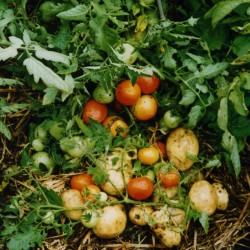Special Offers
Redeem Offer Code
Redeem Gift Voucher
Scarecrow Members
Our Feedback
excellent quality plants when they arrlrived a couple of weeks ago. repotted and they are now all happily planted surrounded by stones and moist soil in the sun, hiding the metal on gabions at the edge of our pond. have a wish list ready for primulas (and others) which will be available in september. highly recommended. No casualties.
sharman, Dorset
Tomtatoes



Solanum sp.
- Tomatoes and Potatoes from one plant!
- Grow outside.
- Easy to grow.
- Great fun!
Do not plant out (without protection) until fear of frost has passed.
Supplied as a pot grown plant.
Available from APPROXIMATELY mid MayGBP1 or more £5.99 each
Description
Tomatoes and potatoes growing from the same plant! Great fun and it really works, we should know we have been growing and enjoying them since approximately 1975!
The spelling of this interesting plant can be done in so many different ways such as tomtato, tom tato, we simply like tomtatoes as they produce lots of delicious tomato fruits and potatoes!
Recommended for outdoor planting only.
Specially featured many years ago in the book Indoor Farming by David Wickers and by Anglia TV.
- Soil Preparation.
- Only plant out from late May until mid June for a superb crop of potatoes and the best flavoured tomatoes you've ever tasted.
- The Tomtatoe requires a soil that is rich in humus or compost, spent mushroom compost is ideal! Work this in to the soil, pricked in with a fork, to the top 4 - 6" (10 - 15 cm), the idea being that the soil is open and `fluffed up'. You can incorporate an organic plant feed at about 4 ozs (110 grammes) per square yard (0.85 square metres), again just lightly pricked into the soil.
- Planting You Tomtatoes - Plant Pot And All!
- Ideally you should plant 3 feet (90 cm) apart by 2 feet (60 cm)
- Do not remove the pot. You should plant the complete pot as it is and the rim or top of the pot should be 4" (10 cm) from the surface of the soil. The bottom of the pot should be in direct contact with moist compost or even peat, it must not dry out. At planting time place a 4 foot (120 cm) cane against the outside of the pot pushed into the soil; in time you will need to tie in loosely the Tomato part of the plant. No harm will come to the Tomato part of the plant being buried by 4" (10 cm) as roots will grow from the stem.
- Growing.
- The potato shoots/leaves have a spoon shaped appearance and as they grow draw them aside to encourage them to spread outwards and away from the central plant.
- When the shoots are about 9" (22 cm) long cover the lower 6" (15 cm) with soil or compost - this is where your potatoes grow from.
- The Tomato part of the plant will grow upwards in the usual way, pinch out the Tomato shoots one leaf beyond the fourth flower truss.
- When the first flower trusses appear of the tomato, feed at 10 day intervals by way of a good drench of No2 Strength of our Instant Life solution; this should be watered over all the foliage and of the potato part of the plant too.
- Important - Do not do this in bright sunlight, it should be done late evening only, after the sun has gone down so that combined with the beneficial effects of night dew as well as `feed' getting to the roots it is also absorbed through the foliage, ie foliar feeding.
- The better the soil and the loose compost the better your ultimate crop of both potatoes and tomatoes.
- Do not be in a hurry to harvest these special potatoes which are well suited for boiling, saute, chips or as `new potatoes'; boil and allow to go cold, chop with a little chive or onion and serve just warmed with a little fresh mint in a steamer - delicious!
- When the potato haulm or leaves turn yellow brown in late Summer the plant is `spent' meaning it will not produce any more potatoes.
- Be sure to harvest before frost.
- New Potatoes In March?
- The Victorians new a trick or two about gardening - so do we! Try this experiment.
- In late Summer remove some potatoes the size of small eggs. Before the skins have set, ie dried in the sun, have an old biscuit tin (not a polythene bag) in which you have placed some moist, not soggy wet, sharp sand. Lay your potatoes not touching on the sand and cover with sand - about 2" (5 cm), on top place another layer and finally pack with sand. Replace the lid and bury the tin in a frost free place in the soil. Come Christmas, January - March as you please remove the tin and remove the potatoes. Do not peel but steam 'til cooked. Serve with a knob of butter and a little mint that you froze for Winter use and, yummy, you have new potatoes out of Season!
- Top Tips
- Always keep your Tomtatoes free of weeds by either hand pulling or a light hoe.
- Do not use herbicides/weed killers.
- At the end of Season lift the old pot and discard.
- Always grow Tomtatoes on a fresh patch each year!
- Growing in Grow Bags? Yes you can but ideally you would need two grow bags, one laid on top of another! You would plant through the top bag into the lower bag. The potatoes would be produced in the top bag. Cropping potential would not be so high by this method as growing in the open soil.

 01233 740529
01233 740529


